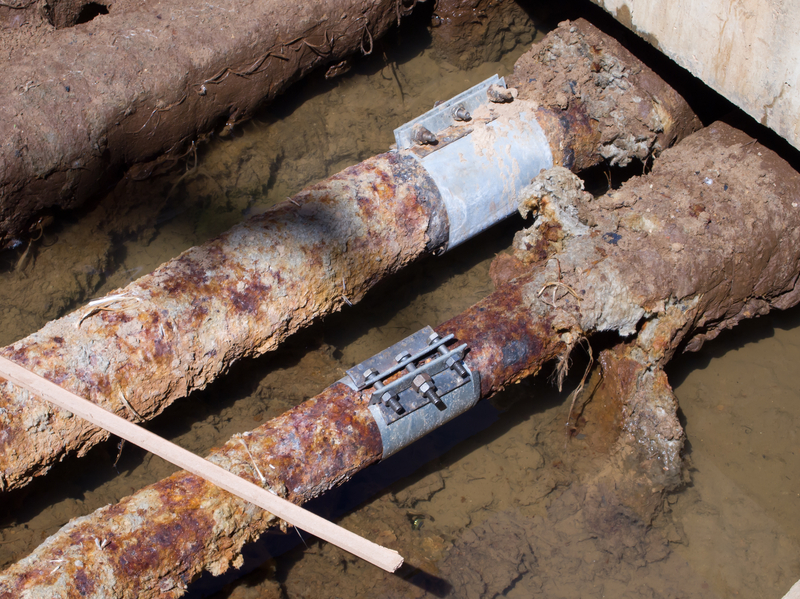Alberta Material 30 PDH Discount Package 2
Courses in this Package
An Introduction to Cathodic Protection Inspection and Testing (E05-007)
An Introduction to Cathodic Protection Principles (E05-006)
Coating Types and Selection (T06-002)
Coating Application and Inspection (T03-001)
Corrosion: Overview (H04-001)
Overview of Insulation Materials (T05-004)
Pre-Coating Surface Preparation (T02-003)

This online engineering PDH course provides an introduction to cathodic protection inspection and testing techniques for galvanic and impressed current systems. It includes criteria and inspection actions that, when used either separately or in combination, will indicate whether adequate cathodic protection of a metallic piping system has been achieved.
The effectiveness of cathodic protection or other corrosion control measures can be affirmed by visual observation, measurements of pipe wall thickness, or by use of internal inspection devices. Because such methods sometimes are not practical, meeting any criterion or combination of criteria in this chapter is evidence that adequate cathodic protection has been achieved. When excavations are made for any purpose, the pipe should be inspected for evidence of corrosion and/or coating condition. Apply sound engineering practices to determine the methods and frequency of testing required to satisfy these criteria.
The criteria in this discussion have been developed through laboratory experiments and/or verified by evaluating data obtained from successfully operated cathodic protection systems. Situations may exist where a single criterion for evaluating the effectiveness of cathodic protection may not be satisfactory for all conditions. Often a combination of criteria is needed for a single structure.
This 5 PDH online course is intended for civil engineers, structural engineers, mechanical engineers, electrical engineers and other design and construction professionals seeking an introduction to the principles of inspection and testing of cathodic protection systems.
This P.Eng. continuing education course is intended to provide you with the following specific knowledge and skills:
-
Learning about the National Association of Corrosion Engineers (NACE) standards
-
Understanding the importance of negative cathode potential
-
Learning how to inspect and test bare or ineffectively coated pipelines where long line corrosion activity is of a primary concern
-
Understanding how aluminum may suffer from corrosion under high pH conditions
-
Learning the fundamentals of inline inspection of pipes
-
Learning about stray currents and stray electrical gradients
-
Learning how to test for a short between two structures with cathodic protection on one structure
-
Knowing when you should test for a short between two structures without cathodic protection on either structure
-
Understanding the current requirement testing procedures
-
Learning about the use of temporary anodes
-
Learning about anode bed inspection and testing for impressed current cathodic protection systems
In this professional engineering CEU course, you need to review the course document titled, "An Introduction to Cathodic Protection Inspection and Testing".
Upon successful completion of the quiz, print your Certificate of Completion instantly. (Note: if you are paying by check or money order, you will be able to print it after we receive your payment.) For your convenience, we will also email it to you. Please note that you can log in to your account at any time to access and print your Certificate of Completion.

This online engineering PDH course will provide you with an introduction to the principles of cathodic protection for underground and underwater structures. You will be introduced to the physics and chemistry of the corrosion process and how to mitigate the corrosion using cathodic protection techniques.
Understanding the principles of cathodic protection systems is based upon understanding the nature of the corrosion process. The corrosion of metals is an electrochemical process. That is, it is an electrical circuit where the exchange of electrons (electricity) is conducted by chemical reactions in part of the circuit. These chemical reactions occur at the surface of the metal exposed to the electrolyte.
Cathodic protection is the prevention of corrosion by making a metal, which would ordinarily behave like an anode and corrode, behave like a cathode and be free from corrosive attack. Essentially, cathodic protection is predetermining the anode in the corrosion cell, or making a large corrosion cell to overcome the other smaller corrosion cells.
This 5 PDH online course is intended for civil engineers, structural engineers, mechanical engineers and other design and construction professionals seeking an introduction to the principles of cathodic protection.
This P.Eng. continuing education course is intended to provide you with the following specific knowledge and skills:
-
Understanding the chemistry and physics behind the corrosion process
-
Learning about the different types of corrosion activity
-
Knowing the corrosion rates for different metals
-
Understanding the importance of the galvanic series of metals
-
Understanding the fundamentals of the sacrificial anode approach to corrosion protection
-
Learning about the basics of the impressed current process
In this professional engineering CEU course, you need to review the course document titled, "An Introduction to Cathodic Protection Principles".
Upon successful completion of the quiz, print your Certificate of Completion instantly. (Note: if you are paying by check or money order, you will be able to print it after we receive your payment.) For your convenience, we will also email it to you. Please note that you can log in to your account at any time to access and print your Certificate of Completion.

This online engineering PDH course presents each type of coating resin or binder categorized by its film-forming mechanism, different types of pigments, and the various solvent families. It also discusses drying oils which are an integral part of some coating formulations, as well as, driers that aid in the drying reaction. Furthermore, it describes miscellaneous additives that are formulated into many coatings for specific purposes. It also provides guidance on powder coatings, thermal spray organic and inorganic coatings, and galvanizing tapes and wraps.
This course also presents a systematic approach to coating selection for new construction and maintenance painting. It details the criteria for selecting a coating system based on the service environment(s), surface preparation requirements, and options for coating application. Finally, it discusses other considerations such as VOC concerns, coating cost, supplier recommendations, ease of application, and maintainability.
This 6 PDH online course is applicable to engineers, design and construction personnel, and other technical professionals who are interested in gaining a better understanding of coating types, characteristics and selection.
This P.Eng. continuing education course is intended to provide you with the following specific knowledge and skills:
- Familiarizing with the various types of film-forming mechanisms
- Understanding how resins (binders) are formed and their underlying pigments
- Learning about drying oil coatings and their corresponding driers
- Understanding the function of solvents in coatings
- Learning about the various additives and their purposes
- Understanding zinc-rich coatings vs. powder and their applications
- Understanding the environmental impacts of volatile organic compounds
- Understanding the process of thermal spray and galvanized coatings
- Learning about how to protect piping and tubular structural shapes with tapes and wraps
- Determining the criteria for selecting a coating system
- Understanding the degree of exposure to atmospheric elements
- Selecting coating systems for ferrous components in fresh water vs. seawater
- Selecting coating systems for black iron and steel pipes
In this professional engineering CEU course, you need to review Chapters 4 and 5 of the "Painting: New Construction and Maintenance" engineering manual, published by the United States Army of Corps of Engineers (USACE), Publication Number EM 1110-2-3400.
Upon successful completion of the quiz, print your Certificate of Completion instantly. (Note: if you are paying by check or money order, you will be able to print it after we receive your payment.) For your convenience, we will also email it to you. Please note that you can log in to your account at any time to access and print your Certificate of Completion.

This online engineering PDH course presents the technologies, techniques, advantages and limitations, equipment, typical coating types involved, and safety considerations for each type of application method.
The choice of an application method depends on the type of coating to be applied, the type and size of surface to be coated, and governing environmental regulations. There are various methods of coating application, including brush application, roller application, conventional spray, high volume-low pressure spray, airless spray, plural component spray, and electrostatic spray.
Approximately 85 percent of all premature coating failures are a result of poor surface preparation, inadequate mixing, thinning, and/or poor coating application. Onsite quality control inspection during surface preparation and coating application procedures can help prevent failures of these types. Proper inspection techniques must be combined with knowledgeable instrument use, good common sense, and thorough documentation of work activities and inspection checkpoints to help ensure specification compliance. The amount of inspection and the specific inspection checkpoints will vary with the type and size of the coating project. This course presents eleven quality control inspection procedures as follows:
- Pre-surface preparation inspection
- Ambient conditions
- Compressed air cleanliness
- Surface profile
- Surface cleanliness
- Paint storage, mixing, and thinning procedures
- Application techniques
- Wet and dry coating thickness
- Pinhole detection
- Adhesion
- Cure
This 3 PDH online course is applicable to engineers, design and construction personnel, and other technical professionals who are interested in gaining a better understanding of coating application and inspection.
This P.Eng. continuing education course is intended to provide you with the following specific knowledge and skills:
- Methods of coating application
- Documentation of coating applications
- Pre-surface preparation inspection
- Measurement of ambient conditions
- Assessment of compressed air cleanliness
- Measurement of surface profile
- Evaluation of surface cleanliness
- Paint storage, mixing, and thinning
- Measurement of wet coating thickness
- Nondestructive measurement of dry coating thickness
- Destructive measurement of dry coating thickness
- Cleanliness and time (cure) between coats
- Holiday/pinhole detection
- Adhesion testing and evaluation
In this professional engineering CEU course, you need to review Chapters 8 and 9 of the “Painting: New Construction and Maintenance” engineering manual, published by the United States Army of Corps of Engineers (USACE), Publication Number EM 1110-2-3400.
Upon successful completion of the quiz, print your Certificate of Completion instantly. (Note: if you are paying by check or money order, you will be able to print it after we receive your payment.) For your convenience, we will also email it to you. Please note that you can log in to your account at any time to access and print your Certificate of Completion.

This online engineering PDH course provides basic information on the chemical interaction taking place during the corrosion process between the environment and the corroding metal. It also describes preventive measure to minimize or control the corrosion process.
Uncontrolled corrosion can cause many serious problems. Corrosion occurs continuously, and every metal in every facility is subject to some type of corrosion. Even though corrosion cannot be eliminated, it can be controlled.
This 4 PDH online course is applicable to chemical and environmental engineers, design and construction personnel, technical staff and facility operators who are interested in gaining a better understanding of the theory of corrosion.
This P.Eng. continuing education course is intended to provide you with the following specific knowledge and skills:
- Corrosion theory
- General corrosion
- Crud and galvanic corrosion
- Specialized corrosion
In this professional engineering CEU course, you need to review Module 2, "Corrosion" of the Department of Energy Publication DOE-HDBK-1015/1-93, "Chemistry".
Upon successful completion of the quiz, print your Certificate of Completion instantly. (Note: if you are paying by check or money order, you will be able to print it after we receive your payment.) For your convenience, we will also email it to you. Please note that you can log in to your account at any time to access and print your Certificate of Completion.

This online engineering PDH course provides an overview of insulation materials including their properties, selection, applications and benefits.
Prevention of heat loss by application of insulation is the simplest method of achieving substantial economies in energy. Some estimates have predicted that insulation in US industry alone saves approximately 200 million barrels of oil every year. The other benefits include the improved productivity, enhanced environmental quality, personal safety, process control, reduction in noise levels and also the fire safety.
The most important characteristics of an insulation material is low thermal conductivity, low tendency toward absorbing water, and of course the material should be inexpensive. The type of insulation selected should be able to withstand whatever conditions it will experience without degradation. In process industry, the most common insulators are various types of calcium silicate or fiberglass. Calcium silicate is generally more appropriate for temperatures above 225°C (437°F), while fiberglass is generally used at temperatures below 225°C (437°F).
This 5 PDH online course is aimed at mechanical, chemical & process engineers; system design engineers working in process, manufacturing and engineering industries; energy auditors, operational & maintenance personnel, health & safety personnel and loss prevention engineers.
This P.Eng. continuing education course is intended to provide you with the following specific knowledge and skills:
- Understanding the application, characteristics and benefits of insulation to industry
- Learning about the key properties of thermal insulation products
- Understanding the selection aspects of insulating materials
- Learning about the organic & Inorganic type of insulation materials
- Learning how to classify of insulting materials on hot and cold surfaces
- Familiarizing with the forms and shapes of insulating materials
- Learning about insulation finishes, vapor retarders and weather barriers
- Understanding the method of installation using hangers and supports
- Familiarizing with the recommended best practices, applicable codes & standards
- Knowing the application areas such as pipelines, vessels, stacks, furnaces, kilns etc.
- Learning how to conserve energy
- Understanding the concept of economic thickness of insulation and selection alternatives
In this professional engineering CEU course, you need to review the course document titled “Overview of Insulation Materials”.
Upon successful completion of the quiz, print your Certificate of Completion instantly. (Note: if you are paying by check or money order, you will be able to print it after we receive your payment.) For your convenience, we will also email it to you. Please note that you can log in to your account at any time to access and print your Certificate of Completion.

This online engineering PDH course describes surface preparation standards, common methods of surface preparation, and abrasive type and selection methods.
Surface preparation is the key factor in determining the success of a protective coating system. The equipment and techniques that can be used to achieve the desired surface cleanliness and roughness (profile) vary considerably. Traditional methods of surface preparation are now accompanied by new, innovative methods that have evolved mainly because of the issues surrounding the safe removal of lead-containing coatings from industrial structures. The ultimate objective of surface preparation is to create proper adhesion of a coating over an underlying substrate.
This 2 PDH online course is applicable to engineers, design and construction personnel, and other technical professionals who are interested in gaining a better understanding of surface preparation prior to coating applications.
This P.Eng. continuing education course is intended to provide you with the following specific knowledge and skills:
- Common methods of surface preparation
- Abrasive type and selection
- Surface preparation standards and specifications
In this professional engineering CEU course, you need to review Chapter 7 of the "Painting: New Construction and Maintenance" engineering manual, published by the United States Army of Corps of Engineers (USACE), Publication Number EM 1110-2-3400.
Upon successful completion of the quiz, print your Certificate of Completion instantly. (Note: if you are paying by check or money order, you will be able to print it after we receive your payment.) For your convenience, we will also email it to you. Please note that you can log in to your account at any time to access and print your Certificate of Completion.